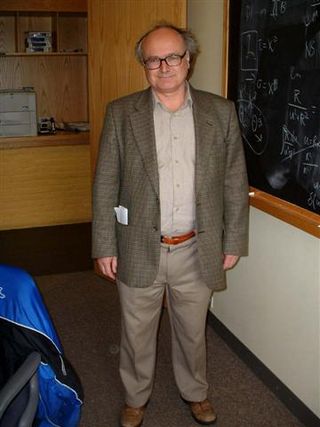Related Research Articles
In physics, string theory is a theoretical framework in which the point-like particles of particle physics are replaced by one-dimensional objects called strings. String theory describes how these strings propagate through space and interact with each other. On distance scales larger than the string scale, a string looks just like an ordinary particle, with its mass, charge, and other properties determined by the vibrational state of the string. In string theory, one of the many vibrational states of the string corresponds to the graviton, a quantum mechanical particle that carries the gravitational force. Thus, string theory is a theory of quantum gravity.

Michael James Duff FRS, FRSA is a British theoretical physicist and pioneering theorist of supergravity who is the Principal of the Faculty of Physical Sciences and Abdus Salam Chair of Theoretical Physics at Imperial College London.

Nathan "Nati" Seiberg is an Israeli American theoretical physicist who works on quantum field theory and string theory. He is currently a professor at the Institute for Advanced Study in Princeton, New Jersey, United States.
Jeffrey A. Harvey is an American string theorist at the University of Chicago.
In theoretical physics and quantum physics, a graviphoton or gravivector is a hypothetical particle which emerges as an excitation of the metric tensor in spacetime dimensions higher than four, as described in Kaluza–Klein theory. However, its crucial physical properties are analogous to a (massive) photon: it induces a "vector force", sometimes dubbed a "fifth force". The electromagnetic potential emerges from an extra component of the metric tensor , where the figure 5 labels an additional, fifth dimension.

Gary William Gibbons is a British theoretical physicist.
Savas Dimopoulos is a particle physicist at Stanford University. He worked at CERN from 1994 to 1997. Dimopoulos is well known for his work on constructing theories beyond the Standard Model.
Emil John Martinec is an American string theorist, a physics professor at the Enrico Fermi Institute at the University of Chicago, and director of the Kadanoff Center for Theoretical Physics. He was part of a group at Princeton University that developed heterotic string theory in 1985.

Bernard Julia is a French theoretical physicist who has made contributions to the theory of supergravity. He graduated from Université Paris-Sud in 1978, and is directeur de recherche with the CNRS working at the École Normale Supérieure. In 1978, together with Eugène Cremmer and Joël Scherk, he constructed eleven-dimensional supergravity. Shortly afterwards, Cremmer and Julia constructed the classical Lagrangian for four-dimensional N=8 supergravity by dimensional reduction from the 11-dimensional theory. Julia also studied spontaneous symmetry breaking and the Higgs mechanism in supergravity
Bruno Zumino was an Italian theoretical physicist and faculty member at the University of California, Berkeley. He obtained his DSc degree from the University of Rome in 1945.
The history of string theory spans several decades of intense research including two superstring revolutions. Through the combined efforts of many researchers, string theory has developed into a broad and varied subject with connections to quantum gravity, particle and condensed matter physics, cosmology, and pure mathematics.
Sergio Ferrara is an Italian physicist working on theoretical physics of elementary particles and mathematical physics. He is renowned for the discovery of theories introducing supersymmetry as a symmetry of elementary particles and of supergravity, the first significant extension of Einstein's general relativity, based on the principle of "local supersymmetry". He is an emeritus staff member at CERN and a professor emeritus at the University of California, Los Angeles.

Renata Elizaveta Kallosh is a Russian-American theoretical physicist. She is a professor of physics at Stanford University, working there on supergravity, string theory and inflationary cosmology.
In quantum field theory, a Slavnov–Taylor identity is the non-Abelian generalisation of a Ward–Takahashi identity, which in turn is an identity between correlation functions that follows from the global or gauged symmetries of a theory, and which remains valid after renormalization. The identity was originally discovered by Gerard 't Hooft, and it is named after Andrei Slavnov and John C. Taylor who rephrased the identity to hold off the mass shell.

Gian Francesco Giudice is an Italian theoretical physicist working at CERN in particle physics and cosmology.
Peter Christopher West, born on 4 December 1951, is a British theoretical physicist at King's College, London and a fellow of the Royal Society.
Michael Dine is an American theoretical physicist, specializing in elementary particle physics, supersymmetry, string theory, and physics beyond the Standard Model.
Martin B. Einhorn is an American theoretical physicist.
Hermann Nicolai is a German theoretical physicist and director emeritus at the Max Planck Institute for Gravitational Physics in Potsdam-Golm.
Costas Christou Kounnas was a Cypriot theoretical physicist, known for his research on string theory, supersymmetry, supergravity, GUTs, and quantum chromodynamics.
References
- ↑ Gibbons, G. W; Hawking, S. W; Perry, M. J (1978). "Path Integrals and the Indefiniteness of the Gravitational Action". Nucl. Phys. B 138 (1): 141–150. Bibcode:1978NuPhB.138..141G. doi:10.1016/0550-3213(78)90161-X.
- ↑ Myers, Robert C.; Perry, M. J (1986). "Black Holes in Higher Dimensional Space-Times". Annals of Physics. 172 (2): 304–347. Bibcode:1986AnPhy.172..304M. doi:10.1016/0003-4916(86)90186-7.
- ↑ David J. Gross, Malcolm J. Perry (1983). "Magnetic Monopoles in Kaluza-Klein Theories". Nucl. Phys. B. 226 (1): 29–48. Bibcode:1983NuPhB.226...29G. doi:10.1016/0550-3213(83)90462-5.
- ↑ Curtis Callan Jr., Emil J. Martinec, Daniel Friedan, Malcolm J. Perry (1985). "Strings in background fields". Nucl. Phys. B. 262 (4): 593–609. Bibcode:1985NuPhB.262..593C. doi:10.1016/0550-3213(85)90506-1.
{{cite journal}}: CS1 maint: multiple names: authors list (link) - ↑ David Berman; Malcolm J. Perry (2011). "Generalized geometry and M theory". JHEP. 1106 (6): 74. arXiv: 1008.1763 . Bibcode:2011JHEP...06..074B. doi:10.1007/JHEP06(2011)074. S2CID 118482271.